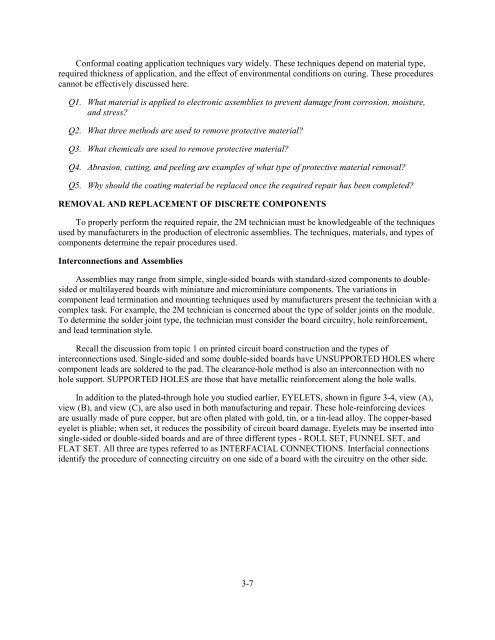Navy Electricity and Electronics Training Series - Historic Naval ...
Navy Electricity and Electronics Training Series - Historic Naval ...
Navy Electricity and Electronics Training Series - Historic Naval ...
Create successful ePaper yourself
Turn your PDF publications into a flip-book with our unique Google optimized e-Paper software.
Conformal coating application techniques vary widely. These techniques depend on material type,required thickness of application, <strong>and</strong> the effect of environmental conditions on curing. These procedurescannot be effectively discussed here.Q1. What material is applied to electronic assemblies to prevent damage from corrosion, moisture,<strong>and</strong> stress?Q2. What three methods are used to remove protective material?Q3. What chemicals are used to remove protective material?Q4. Abrasion, cutting, <strong>and</strong> peeling are examples of what type of protective material removal?Q5. Why should the coating material be replaced once the required repair has been completed?REMOVAL AND REPLACEMENT OF DISCRETE COMPONENTSTo properly perform the required repair, the 2M technician must be knowledgeable of the techniquesused by manufacturers in the production of electronic assemblies. The techniques, materials, <strong>and</strong> types ofcomponents determine the repair procedures used.Interconnections <strong>and</strong> AssembliesAssemblies may range from simple, single-sided boards with st<strong>and</strong>ard-sized components to doublesidedor multilayered boards with miniature <strong>and</strong> microminiature components. The variations incomponent lead termination <strong>and</strong> mounting techniques used by manufacturers present the technician with acomplex task. For example, the 2M technician is concerned about the type of solder joints on the module.To determine the solder joint type, the technician must consider the board circuitry, hole reinforcement,<strong>and</strong> lead termination style.Recall the discussion from topic 1 on printed circuit board construction <strong>and</strong> the types ofinterconnections used. Single-sided <strong>and</strong> some double-sided boards have UNSUPPORTED HOLES wherecomponent leads are soldered to the pad. The clearance-hole method is also an interconnection with nohole support. SUPPORTED HOLES are those that have metallic reinforcement along the hole walls.In addition to the plated-through hole you studied earlier, EYELETS, shown in figure 3-4, view (A),view (B), <strong>and</strong> view (C), are also used in both manufacturing <strong>and</strong> repair. These hole-reinforcing devicesare usually made of pure copper, but are often plated with gold, tin, or a tin-lead alloy. The copper-basedeyelet is pliable; when set, it reduces the possibility of circuit board damage. Eyelets may be inserted intosingle-sided or double-sided boards <strong>and</strong> are of three different types - ROLL SET, FUNNEL SET, <strong>and</strong>FLAT SET. All three are types referred to as INTERFACIAL CONNECTIONS. Interfacial connectionsidentify the procedure of connecting circuitry on one side of a board with the circuitry on the other side.3-7

















